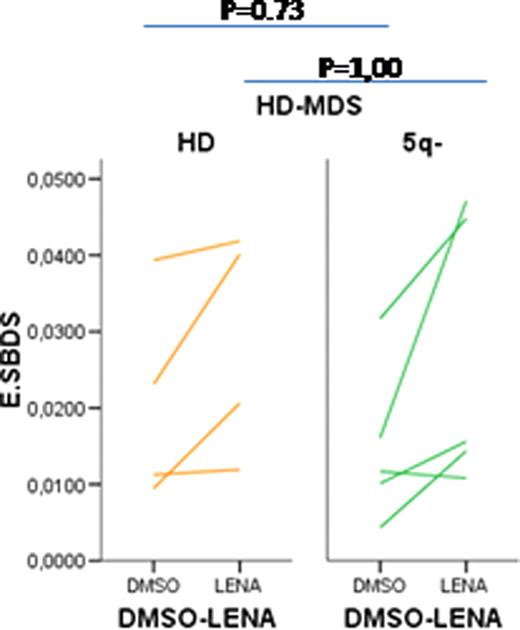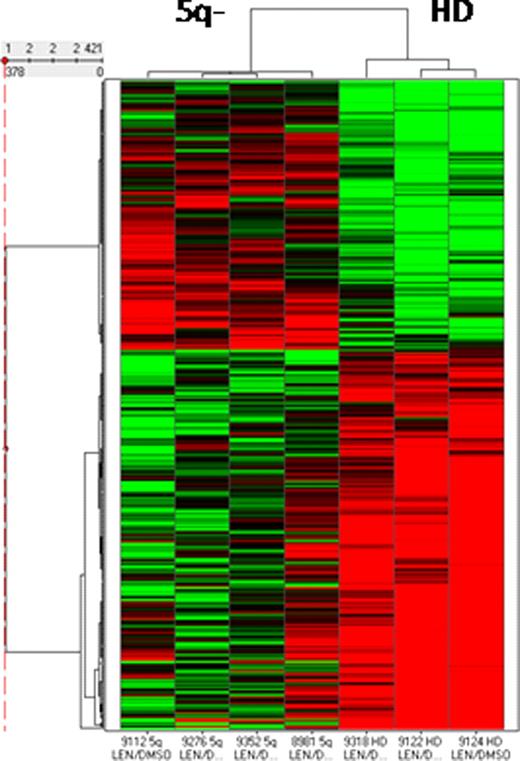Abstract
Abstract 3810
Mesenchymal stromal cells (MSC) are a non-hematopoietic BM cell population considered to be not only the osteoblastic progenitors, but also a key component of the hematopoietic microenvironment. Raaijmakers et al (Nature, 2010) have recently shown that deletion of Dicer1 in MSC-derived osteoprogenitors as well as its target gene SBDS resulted in myelodysplasia (MDS) in a murine model. We have previously confirmed these results in human MSC from MDS patients (ASH 2010, # 397). In a previous paper (Leukemia, 2009) we showed that MSC from 5q- syndrome patients were different from MSC from other types of MDS and could be involved in their development. We have hypothesized that lenalidomide, the standard treatment of 5q- patients could act not only on hematopoietic progenitors but also on the BM microenvironment.
For this purpose BM-MSC from healthy donors (HD) (n=7) and 5q- syndrome patients (n=5) were expanded in vitro and treated with 50 uM lenalidomide or its solvent (DMSO) as control. RNA was obtained from MSC and DICER1, DROSHA and SBDS relative gene expression was assessed by real-time PCR using TaqMan® assay as well as several microRNAs with known role in hematopoiesis and immune system regulation. In addition, MSC gene expression profile was studied. Labeled samples were hybridized to affymetrix of oligonucleotide HU 1.OST arrays in 5q- patients (n=4) and compared with MSCs from HD (n=3). For this purpose the ratio lenalidomide-treated sample and its paired DMSO control was calculated and markers with a fold change >1.5 were selected for hierarchical clustering analysis (HCA).
When microRNAs were analyzed, we observed a lower microRNA expression in lenalidomide-treated MSC from healthy donors when was compared to paired non-treated cells, especially for miRNA-155 (p=0.028), miRNA-222 (p=0.028),and miRNA-181a (p=0.075; Table 1). By contrast, lenalidomide-treated MSC from MDS showed a trend towards higher microRNA expression in comparison to paired non-treated MSC.
| . | HD-MSC DMSO vs LENA . | 5q-MSC DMSO vs LENA . | ||
|---|---|---|---|---|
| miRNA 146 | 0.50 vs 0.30 | p=0.249 | 0.07 vs 0.10 | p=0.7 |
| miRNA 150 | 0.004 vs 0.0065 | p=0.6 | 0.001 vs 0.006 | p=0.07 |
| miRNA 155 | 0.90 vs 0.58 | p=0.028 | 0.80 vs 0.96 | p=0.7 |
| miRNA 181a | 2.47 vs 1,83 | p=0.075 | 1.66 vs 2.32 | p=0.07 |
| miRNA 222 | 86.2 vs 68.0 | p=0.028 | 43.2 vs 56.2 | p=0.07 |
| . | HD-MSC DMSO vs LENA . | 5q-MSC DMSO vs LENA . | ||
|---|---|---|---|---|
| miRNA 146 | 0.50 vs 0.30 | p=0.249 | 0.07 vs 0.10 | p=0.7 |
| miRNA 150 | 0.004 vs 0.0065 | p=0.6 | 0.001 vs 0.006 | p=0.07 |
| miRNA 155 | 0.90 vs 0.58 | p=0.028 | 0.80 vs 0.96 | p=0.7 |
| miRNA 181a | 2.47 vs 1,83 | p=0.075 | 1.66 vs 2.32 | p=0.07 |
| miRNA 222 | 86.2 vs 68.0 | p=0.028 | 43.2 vs 56.2 | p=0.07 |
We can conclude that Lenalidomide not only acts on HPC from 5q- patients but also on microenvironment by modifying the expression of DICER-1 and SBDS as well as the expression of some microRNAs and genes.
San Miguel:Celgene Corp.: Membership on an entity's Board of Directors or advisory committees. del Cañizo:Celgene Corp.: Spanishn Adviory committee.
Author notes
Asterisk with author names denotes non-ASH members.



